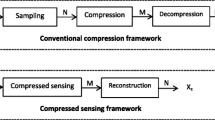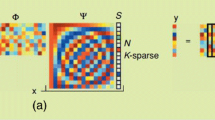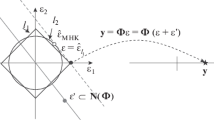Abstract
The possibility of using the method of compressive sensing (CS) to increase the resolution of echo signals is investigated. For comparison with the CS method, the maximum entropy (ME) method used in ultrasonic testing to achieve superresolution was also considered. In model experiments, the possibility of reconstructing images of reflectors with superresolution has been demonstrated making it possible to increase the accuracy of measuring reflectors and reduce the level of pattern noise. In order to reduce the noise level, it is proposed to use a coherence factor (CF) when combining partial images.









Similar content being viewed by others
REFERENCES
Advances in Phased Array Ultrasonic Technology Applications, Waltham: Olympus NDT, 2007. http://www.olympus-ims.com/en/books/. Cited December 9, 2018.
Voronkov, V.A., Voronkov, I.V., Kozlov, V.N., Samokrutov, A.A., and Shevaldykin, V.G., On the applicability of antenna array technology in ultrasonic testing of hazardous production facilities, V Mire NK, 2011, no. 1, pp. 64–70.
Bazulin, E.G., Comparison of systems for ultrasonic nondestructive testing using antenna arrays or phased antenna arrays, Russ. J. Nondestr. Test., 2013, vol. 49, no. 7, pp. 404–423.
Holmes, C., Drinkwater, B.W., and Wilcox, P.D., Post-processing of the full matrix of ultrasonic transmit–receive array data for non-destructive evaluation, NDT & E Int., 2005, vol. 38, no. 8, pp. 701–711.
Kovalev, A.V., Kozlov, V.N., Samokrutov, A.A., Shevaldykin, V.G., and Yakovlev, N.N., Pulse echo method for testing concrete. Interference and spatial selection, Defektoskopiya, 1990, no. 2, pp. 29–41.
Camacho, J., Parrilla, M., and Fritsch, C., Phase coherence imaging, IEEE Trans. Ultrason. Ferroelectr. Freq. Cont., 2009, vol. 56, no. 5, pp. 958–974.
Bazulin, E.G., Two-dimensional adaptive extrapolation of the spectrum of multi-frequency acoustic holograms, Acoust. J., 1991, vol. 37, no. 1, pp. 8–16.
Marple Jr., S.L., Digital Spectral Analysis, Hoboken: Prentice Hall, 1987.
Bazulin, E.G., Increasing the signal-to-noise ratio during joint use of the spectrum extrapolation and splitting methods, Russ. J. Nondestr. Test., 2006, vol. 42, no. 1, pp. 51–59.
Lavielle, M., Bayesian deconvolution of Bernoulli–Gaussian processes, Signal Proces., 1993, vol. 33, no. 1, pp. 67–79. https://doi.org/10.1016/0165-1684(93)90079-P
Benammar, A., Drai, R., Kechida, A., and Guessoum, A., Deconvolution of ultrasonic echoes using Bernoulli- Gaussian processes for composite materials inspection, Int. J. Simul. Multidiscip. Des. Optim., 2008, vol. 2, pp. 107–111.
Richardson, W.H., Bayesian-based iterative method of image restoration, J. Opt. Soc. Am., 1972, vol. 62, pp. 55–59.
Dalitz, C., Pohle-Fronlich, R., and Michalk, T., Point spread functions and deconvolution of ultrasonic images, IEEE Trans. Ultrason. Ferroelectr. Freq. Cont., 2015, vol. 62, no. 3, pp. 531–544. https://doi.org/10.1109/TUFFC.2014.006717
Ermolov, I.N., To the question of choosing the optimum parameters of the pulse-echo method in ultrasonic flaw detection, Defektoskopiya, 1965, no. 6, pp. 51–61.
Bazulin, E., The maximum entropy method in ultrasonic non-destructive testing – increasing the resolution, image noise reduction and echo acquisition rate, Entropy, 2018, vol. 20, no. 8, p. 621. https://doi.org/10.3390/e20080621
Borichin, O.N., Randomization of measurements and l1-optimization, Stokhast. Optim. Inf., 2009, no. 5, pp. 3–23.
Donoho, D.L., Compressed sensing, IEEE Trans. Inf. Theory, 2006, pp. 1289–1306.
Foucart, S. and Rauhut, H., A Mathematical Introduction to Compressive Sensing, Basel: Birkhäuser, 2013.
Guarneri, G.A., Pipa, D.R., Junior, F.N., de Arruda, L.V.R., and Zibetti, M.V.W., A sparse reconstruction algorithm for ultrasonic images in nondestructive testing, Sensors, 2015, vol. 15, pp. 9324–9343.
Minakov, E.I. and Seregin, P.S., Comparative analysis of methods of parallel reconstruction of magnetic resonance imaging images, Tsifrovaya Obrab. Sign., 2012, no. 3, pp. 23–28.
Valente, S.A., Zibetti, M.V.W., Pipa, D.R., Maia, J.M., and Schneider, F.K., An assessment of iterative reconstruction methods for sparse ultrasound imaging, Sensors, 2017, vol. 17, p. 533. https://doi.org/10.3390/s17030533
Provost, J. and Lesage, F., The application of compressed sensing for photo-acoustic tomography, IEEE Trans. Med. Imag., 2009, vol. 28, no. 4, pp. 585–594.
Knee, P., Sparse representations for radar with MATLAB R examples, Synth. Lect. Algorithms Software Eng., 2012, vol. 4, no. 1, pp. 1–85.
Shannon, C.R., A mathematical theory of communication, Bell Syst. Tech. J., 1948, vol. 27, pp. 379–423.
Tikhonov, A.N. and Arsenin, V.Ya., Metodi resheniya nekorrektnikh zadach (Methods for Solving Ill-Posed Problems), Moscow: Nauka, 1986, 3rd ed.
Kullback, S., Information Theory and Statistics, Mineola: Dover, 1968.
Bazulin, E.G., On the possibility of using the maximum entropy method in ultrasonic non-destructive testing to obtain an image of scatterers using a set of echo signals, Acoust. J., 2013, vol. 59, no. 2, pp. 235–254.
Candes, E.J., The restricted isometry property and its implications for compressed sensing, Comptes Rendus de l’Acad. des Sci. Serie I, 2008, vol. 346, p. 589592.
Candes, E. and Wakin, M., People hearing without listening: An Introduction to Compressive Sampling, IEEE Sign. Proces. Mag., 2008, vol. 25, no. 2, pp. 21–30.
Baraniuk, R.G., Davenport, M., DeVore, R., and Wakin, M.B., A simple proof of the restricted isometry principle for random matrices (aka the Johnson-Lindenstrauss lemma meets compressed sensing), Constr. Approximation, 2007, vol. 28, pp. 253–263.
Bradley, E. and Hastie Trevor, Johnstone Yain Least angle regression. Stanford University, Ann. Stat., 2004, vol. 32, no. 2, pp. 407–499.
SPGL1: A solver for Large-Scale Sparse Reconstruction. https://www.cs.ubc.ca/~mpf/spgl1/index.html. Cited December 4, 2018.
Bazulin, E.G. and Evseev, I.V., Reducing the noise level of the image of reflectors reconstructed from echo signals measured by an ultrasonic antenna array, XXVII mezhdunar. nauchno-tekh. konf. stud. aspirantov “Radioelektron. elektrotekh. energetika” (XVII Int. Sci. Tech. Conf. Stud. Postgraduates “Radioelectron. Electron. Power Eng.”) (MPEI, Moscow, March 11–12, 2021), p. 303.
Official site of ECHO+ company. http://www.echoplus.ru. Cited January 22, 2022.
Bazulin, E.G., The use of the inverse C-SAFT method for equalizing the spatial sensitivity of reflector images, Russ. J. Nondestr. Test., 2015, vol. 51, no. 2, pp. 108–119.
Perona, P. and Malik, J., Scale space and edge detection using anisotropic diffusion, IEEE Trans. Pattern Anal. Mach. Intell., 1990, vol. 12, no. 6, pp. 629–639.
Bazulin, E.G., Application of adaptive anisotropic diffusion filter to improve the reflector image quality when performing ultrasonic nondestructive testing, Russ. J. Nondestr. Test., 2021, no. 5, pp. 343–351.
Bazulin, E.G. and Vovk, A.S., Application of the maximum entropy method in ultrasonic flaw detection with allowance for the variable shape of echo signal, Nauchn. Tr. MEI, 2018, no. 5, pp. 111–119.
Bazulin, A.E. and Bazulin, E.G., Application of antenna arrays and organosilicon polymers as an immersion medium for ultrasonic testing of objects with rough surfaces, Russ. J. Nondestr. Test., 2014, vol. 50, no. 7, pp. 377–384.
Fedorov, F.I., Teoriya uprugikh voln v kristallakh (Theory of Elastic Waves in Crystals), Moscow: Nauka, 1965.
Author information
Authors and Affiliations
Corresponding author
Rights and permissions
About this article
Cite this article
Bazulin, E.G. Applying Compression Recognition Method to Achieve Superresolution of Echo Signals. Russ J Nondestruct Test 58, 342–354 (2022). https://doi.org/10.1134/S1061830922050023
Received:
Revised:
Accepted:
Published:
Issue Date:
DOI: https://doi.org/10.1134/S1061830922050023




